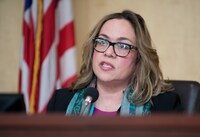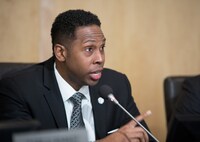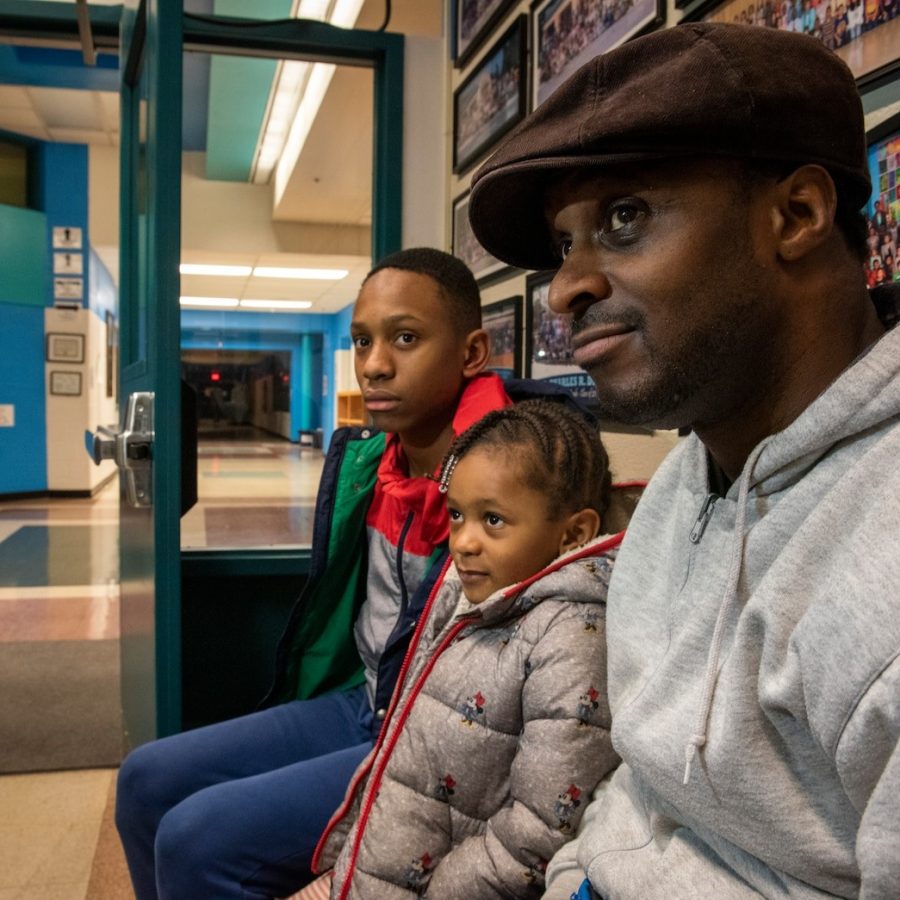Hashim Jabar, right, with children Assata Jabar, 5, and Amir Lumumba, 12, at Charles R. Drew Elementary School in Silver Spring. (Bill O’Leary/The Washington Post)
By
“I constantly live with this fear,” Kelly said. “If there’s a cop, I immediately think: What’s happened to Sadiq?”
These disparate views, in the same liberal Maryland suburb, illustrate the core of a thorny debate that has erupted over a community policing bill. The legislation includes a request to “maintain and expand” Montgomery County’s $3 million School Resource Officer (SRO) program, which places police in the county’s 25 public high schools. While the goal of the legislation was to bridge — not widen — the distance between law enforcement and marginalized groups, the clause on SROs has had the opposite effect.
In January, more than 30 people testified against the proposal to expand the program to Montgomery’s 40 middle schools. At a recent council meeting, activists sat behind Police Chief Marcus Jones, wielding paper signs that read, “KIDS NEED COUNSELORS NOT COPS” and “SROs FEED THE SCHOOL TO PRISON PIPELINE.”
Safety vs. Threat
Across the country, the idea of armed officers in schools has grown more contentious as calls for stronger protections against external threats rub up against concerns of police brutality and racial inequities. A spate of horrific school shootings has led to calls for greater police presence on campuses, including from President Trump.
The issue is particularly fraught in Maryland’s most populous jurisdiction, a once predominantly white suburb where black and Latino children now account for the majority of the student body. The all-Democratic county council last year passed an ambitious racial equity bill while attempting to restore trust in law enforcement following a fatal police shooting and other controversial incidents.

County council member Nancy Navarro (District 4), co-sponsor of the community policing bill, has proposed removing the requirement to expand the SRO program, and other council members agree. But Capt. Sonia Pruitt, who oversees the program, said the county has already approved funding to place police at three middle schools and is looking to expand it further.
Some parents have spent years asking for more police, particularly in the wake of school shootings. Now, however, there are also voices calling for the SRO program to stop growing and perhaps be rolled back.
“I do not see where, at all, education and police go hand in hand,” said Hashim Jabar, 41, who moved to Silver Spring three years ago. In 2016, a fight broke out at his son Amir’s elementary school in Dayton, Ohio. Amir, a 9-year-old at the time, watched as a resource officer placed one of his classmates, who is black, in handcuffs.
“A fourth-grader,” Jabar recounted, shaking his head. “You tell me, that’s not trauma?”
In Chesterfield, Va., a new commonwealth’s attorney has accused the SRO program of contributing to a “school-to-prison pipeline.” In Sacramento, a school board recently voted to cut its number of school-based officers by half.
Elsewhere, criticism has grown amid incidents of officers behaving inappropriately at schools. An officer in Arkansas was recently filmed placing a black student in a chokehold, and another in Florida was caught on a body camera threatening to shoot a high-schooler. In New Mexico, a school officer resigned after pushing a black 11-year-old against a brick wall.
“Any rational adult wants their children to be safe,” said Byron Johns, chair of Montgomery’s NAACP Parents’ Council. “The problem is that for black and brown kids, the police themselves represent a threat.”
Equity and evidence
Studies show black and Latino students, as well as students with disabilities, are disproportionately arrested and disciplined by police in schools. The most recent federal data, from the 2015-2016 school year, shows black students represented 15 percent of total enrollment, but 31 percent of students arrested or referred to law enforcement.
County council member Craig Rice (District 2), a longtime champion of the SRO program, said he is aware of national trends but thinks Montgomery is different.

“Folks continue to espouse things about our SRO program that are not true,” he said at a council meeting. “If you have evidence, please let me know. And if you don’t, please stop saying it.”
Beth Kennington, parent of a student at Northwest High School, said she thinks concerns over the behavior of officers in Montgomery schools are “misplaced” or “made by under-informed individuals.” The officers are an integral part of the school community, Pruitt said, with some working to build trust with students by joining the school band.
According to state data, 60 percent of the arrests in county schools during the 2017-2018 academic year involved black students, who accounted for 20 percent of total enrollment. A separate county report from 2016, however, shows the rates of arrests and school removals in the county are lower than state averages and have been decreasing over time.
Tino Fragale, 22, is one of the activists opposing the SRO program. As a student at Montgomery Blair High School in 2013, he saw an officer use a Taser on a ninth-grade girl in the school courtyard. “It’s just not their role to be in a school,” he said.
Katie Stauss, a member of the Silver Spring Justice Coalition, said she is concerned about “unconscious bias” among officers and school administrators.
School resource officers undergo 40 hours of training that covers topics like conflict resolution and emergency preparedness, Pruitt said. In 2019, they also attended a mandatory conference on de-escalation and disability awareness.
An agreement between the school system and the police department explicitly prohibits officers from becoming involved in school disciplinary proceedings. But a former resource officer, who spoke on the condition of anonymity because he wasn’t authorized to discuss the program, said school administrators asked him multiple times to cite students for trespassing when they refused to leave school premises.
“It’s a fantastic program,” he said. “But MCPS needs to have a clearer understanding on the role of the SROs.”
![Jean Winegardner with her 16-year-old son, who is autistic. She said the prospect of adding more officers to schools “scares [her] to death.”](https://racialjusticenow.org/wp-content/uploads/2023/11/WLMXCECPP4I6VFT34B2NGAWH2Q.jpg)
The Montgomery NAACP chapter has requested more data on the SRO program, including the number of incidents requiring officer intervention and the race of the students involved.
County council member Will Jawando (At Large) said until this data is analyzed, the program should not be expanded. Some activist groups, like Showing Up for Racial Justice, want the county to end it entirely.
County Executive Marc Elrich (D) said he has yet to decide whether to propose additional funding. “I am not without concerns,” he said.
From Columbine to Parkland
Like numerous other school systems, Montgomery started its SRO program in 2002, using a federal grant in the aftermath of the 1999 mass shooting at Columbine High School in Colorado. Funding waned because of budget cuts, but returned in the wake of the Sandy Hook Elementary School shooting in Newtown, Conn., in 2012.

In 2014, Montgomery County posted police at all high schools — a decision that Burkinshaw, who at the time chaired the Council of PTAs’ Committee on Safety, lauded as “phenomenal.”
That committee is now chaired by Gillian Huebner, who said the conversation on police in schools has changed. Today, the council seeks to “ensure adequate security staff” but does not have a formal position on SROs.
“There’s a lot of pushback against SROs, but at the same time, there’s interest in seeing the program expanded,” Huebner said. “There’s a real tension . . . and I don’t think there’s an easy answer here.”
In 2018, a resource officer at Clarksburg High School recovered a loaded handgun from a student on campus, who was later sentenced to four months in jail. More recently, an SRO arrested five students, also at Clarksburg High School, for offenses relating to handgun possession.
“We absolutely cannot do without [SROs],” said Kennington, the Northwest High School parent. “Not in this school climate — not in this day and age, when there are so many threats.”
Stauss, the advocate with the Silver Spring Justice Coalition, said she thinks parents “errantly believe” police can stop school shootings, noting that during the mass shooting at Marjory Stoneman Douglas High School in Parkland, Fla., two years ago, there was an armed officer on campus.
A recent study by a Howard University professor found that schools in North Carolina that added resource officers did not see reductions in reports of disciplinary acts (such as assault or possession of weapons) compared with other schools in the same district.
Stauss, who is white, said she wants to transfer her 14-year-old son, who is black, to a private school, in part because she does not feel he will be safe in a high school with police. Kay Henry, 43, another parent, said part of why she home-schools her autistic daughter is to limit her interaction with law enforcement.
“I don’t feel like my kids are safer from outside threats because of one SRO,” said Jean Winegardner, a mother of two autistic children. “I see [SROs] as a threat, if not to my child than to other children.”
‘That could be me’
On a rainy evening, Amir Lumumba, 12, sat on a bench at Charles R. Drew Elementary School, where he attended and his little sister is in kindergarten. Amir is 5-foot-8 — a lanky, soft-spoken seventh-grader. He says some police are nice but a majority — “70 to 80 percent” — are dangerous.
At Francis Scott Key Middle School, most of his friends are black or Hispanic, he said. Sometimes, at lunch, they talk about reports of police pinning students to the ground. When he watches those videos, Amir said, he always feels the same way he did three years ago, sitting at the back of a classroom in Dayton.
“I think to myself, that could be me.”






